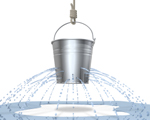Blocking sound is often analogized to plugging the holes in a leaky bucket. If you plug up all the bucket holes except one, the bucket is still going to drain. In acoustics, an outstanding partition design will not adequately block sound if holes and weak spots exist where sound can find its way through.
For example, let’s examine a room that needs a high level of sound isolation, a music practice room (though these methods apply to many other spaces). We select a wall that performs well in the frequency range that we desire (and for music STC does not adequately address blocking low frequencies, but that’s another topic). Done? No, that’s only the beginning. All of the potential holes have to be addressed.
The wall needs to be full height so that sound doesn’t cross over the wall above the ceiling. (An alternate for high bay areas would be to cap the room with heavy construction.) Also, the wall needs to be properly sealed around its perimeter with acoustical caulk, including special attention to retain the wall integrity at the deck flutes. Intersections at other walls need to be as robust as the wall itself. Any recessed lighting, electrical boxes and data boxes must be strategically placed or sealed with a backing enclosure with the same surface weight as the gypsum board or CMU that it is mounted in. Doors must be acoustically rated or at least sealed around the perimeter (depending on the performance mandate). Door windows must live up to the performance of the door.
Finally, the “hole” most often overlooked is the HVAC system. Ductwork, both supply and return, can channel sound from one space to another. A substantial amount of sound attenuation must be incorporated into the ductwork through design of the routing, acoustical duct liner and sound attenuators. The amount of attenuation in the sound path from one room to another through the HVAC system must be equal to the partition design or the partition STC rating will not be realized through degradation of the whole system.
Sound isolation details can make or break a sound blocking partition. If you’re working on a more complex project, you may want to consider getting some professional advice from an acoustical consultant. Don’t let your partition be degraded by overlooking the holes!
